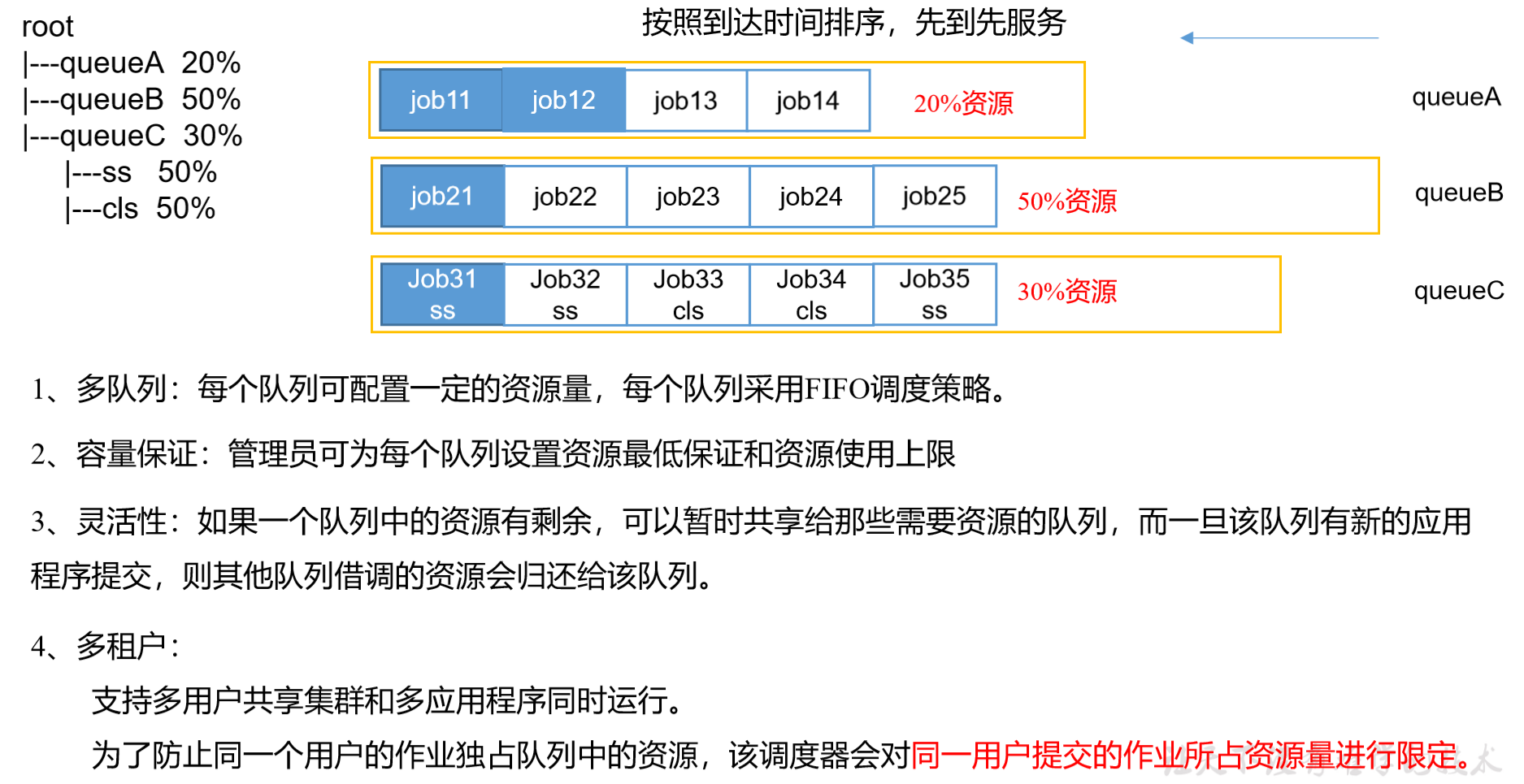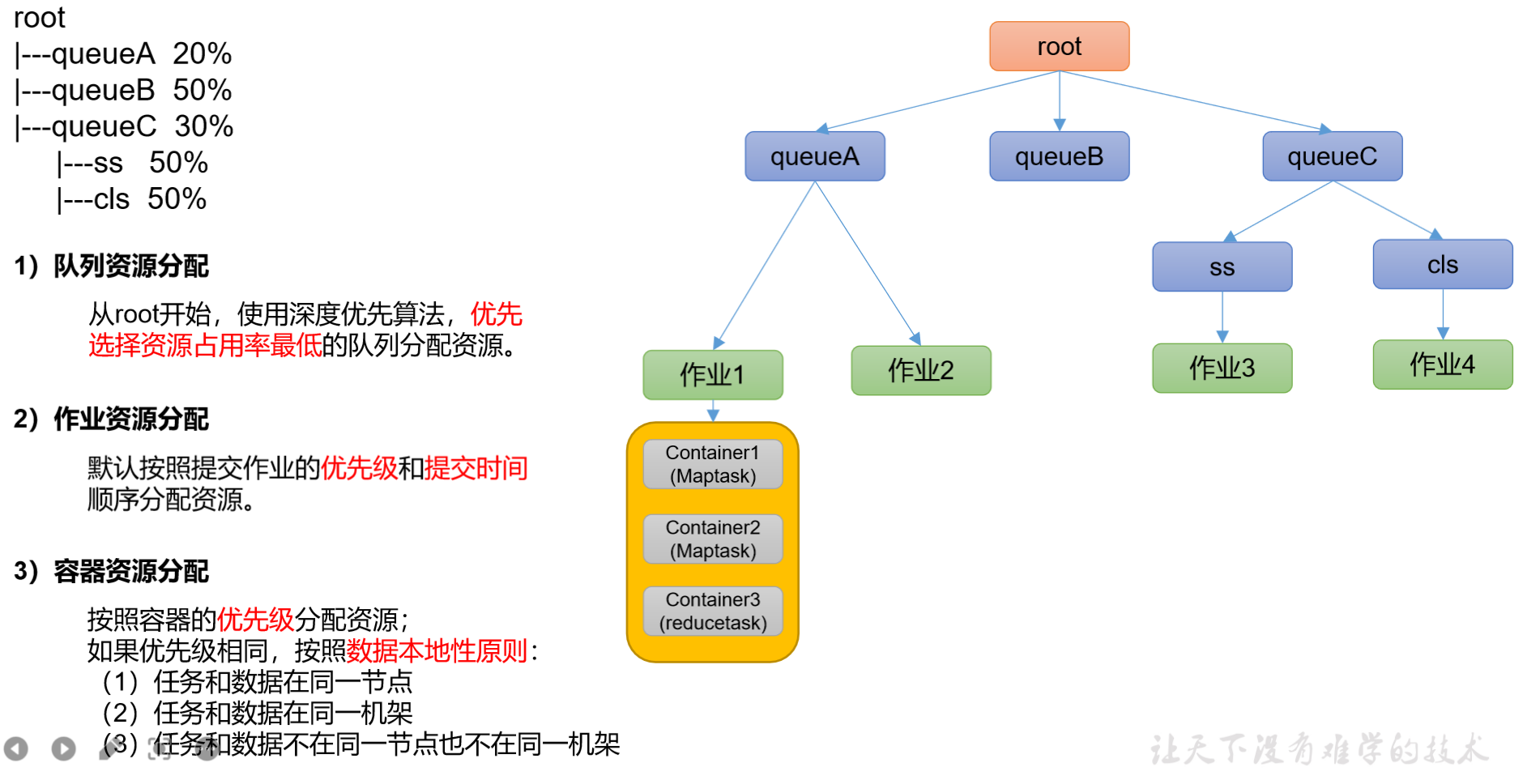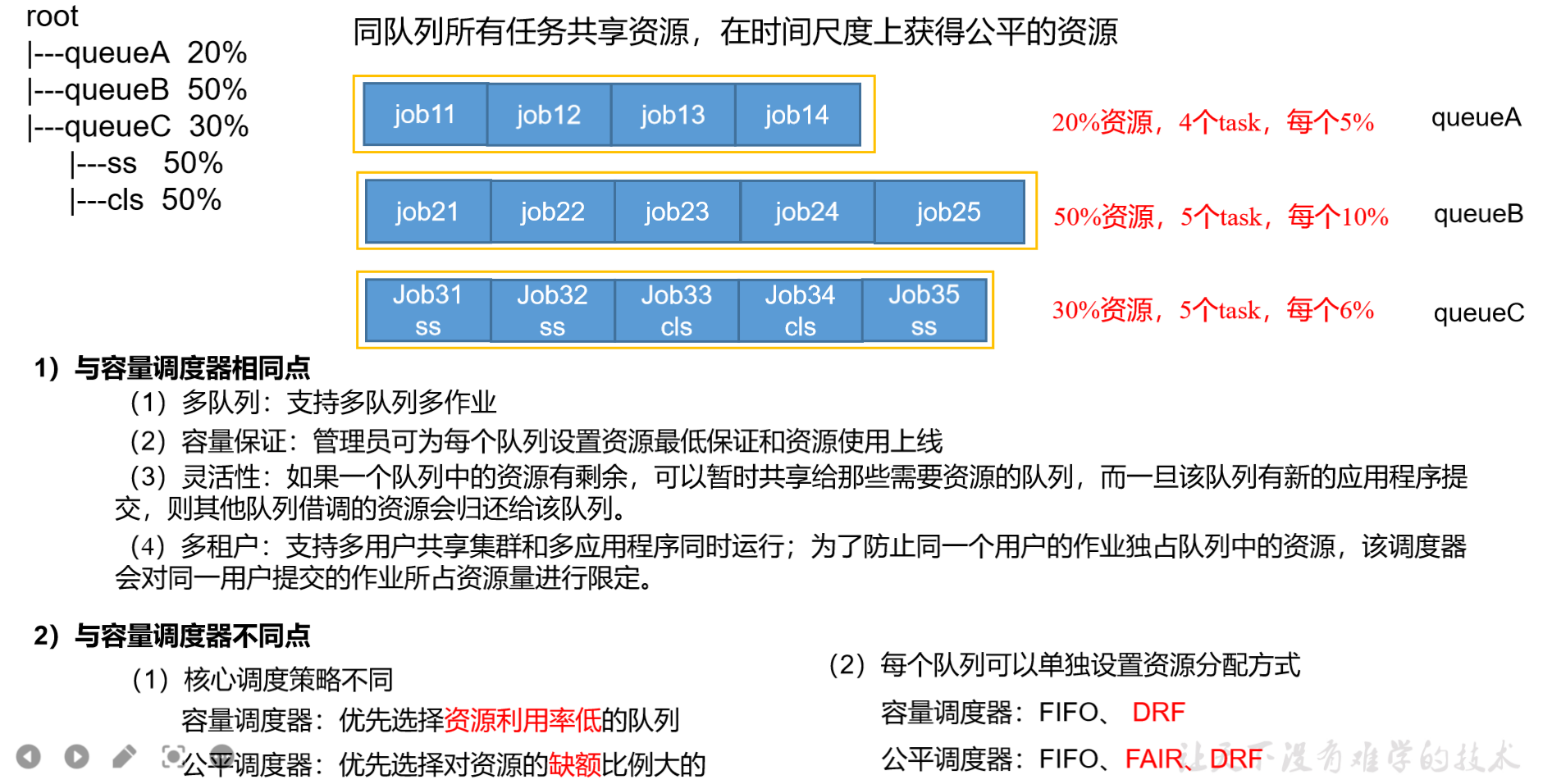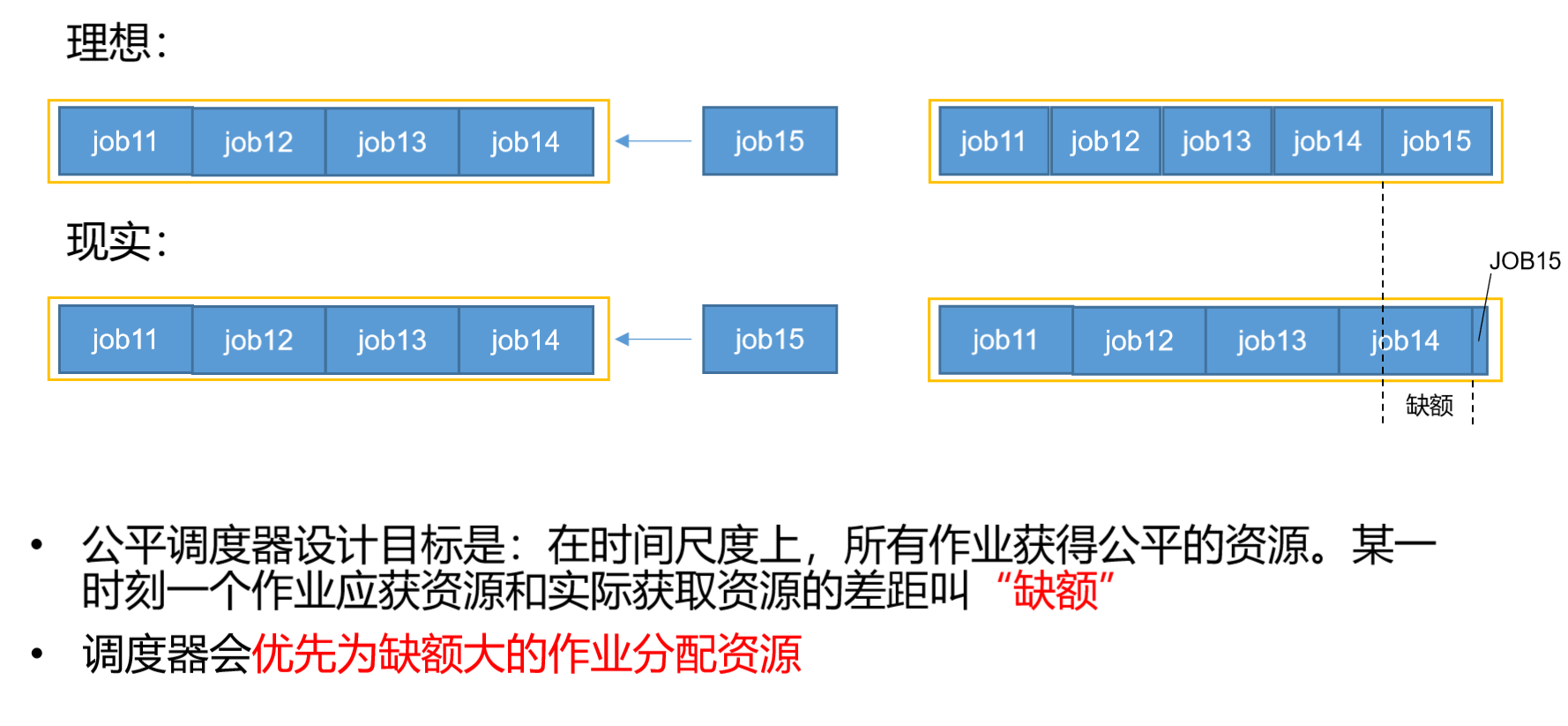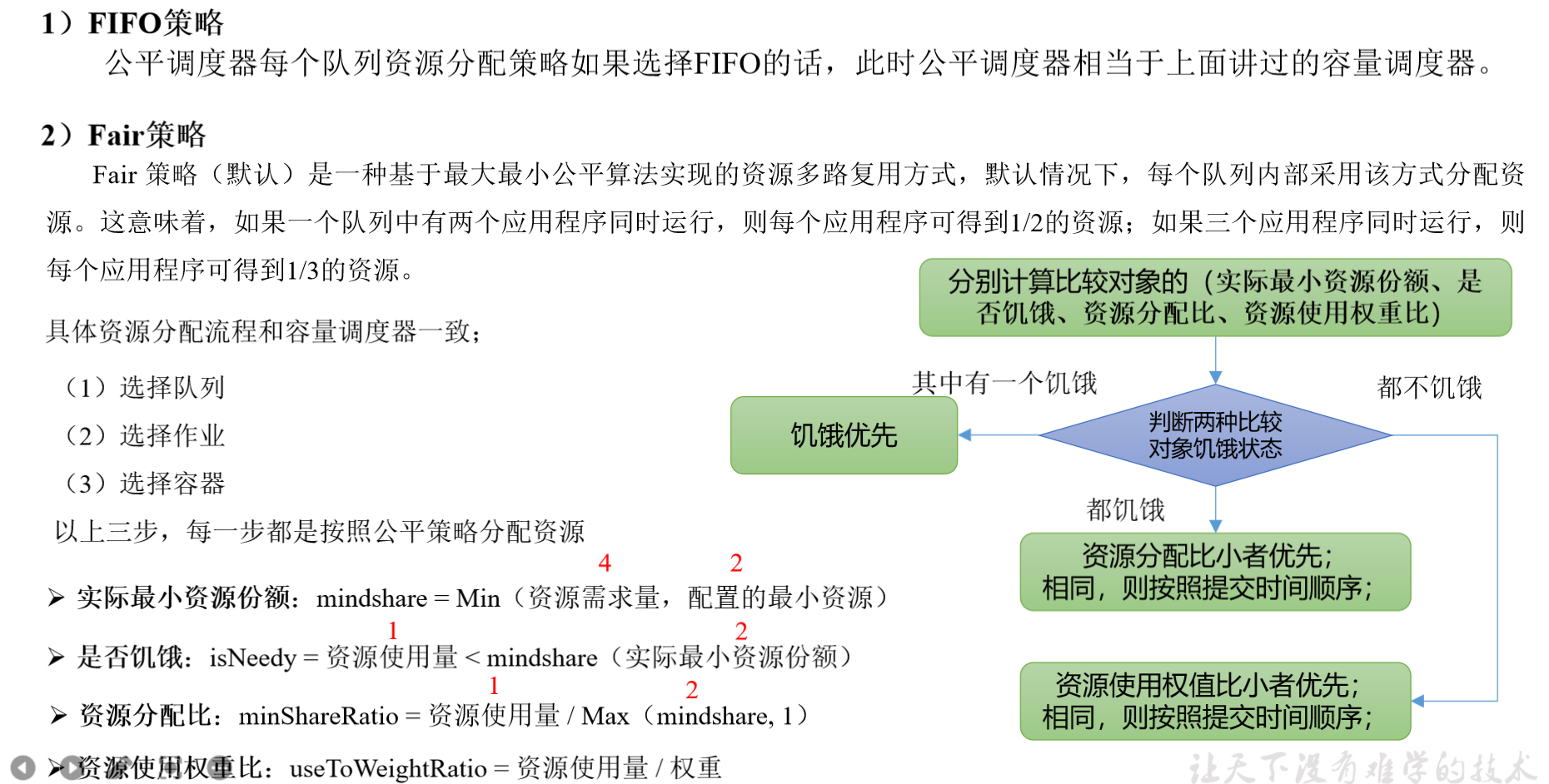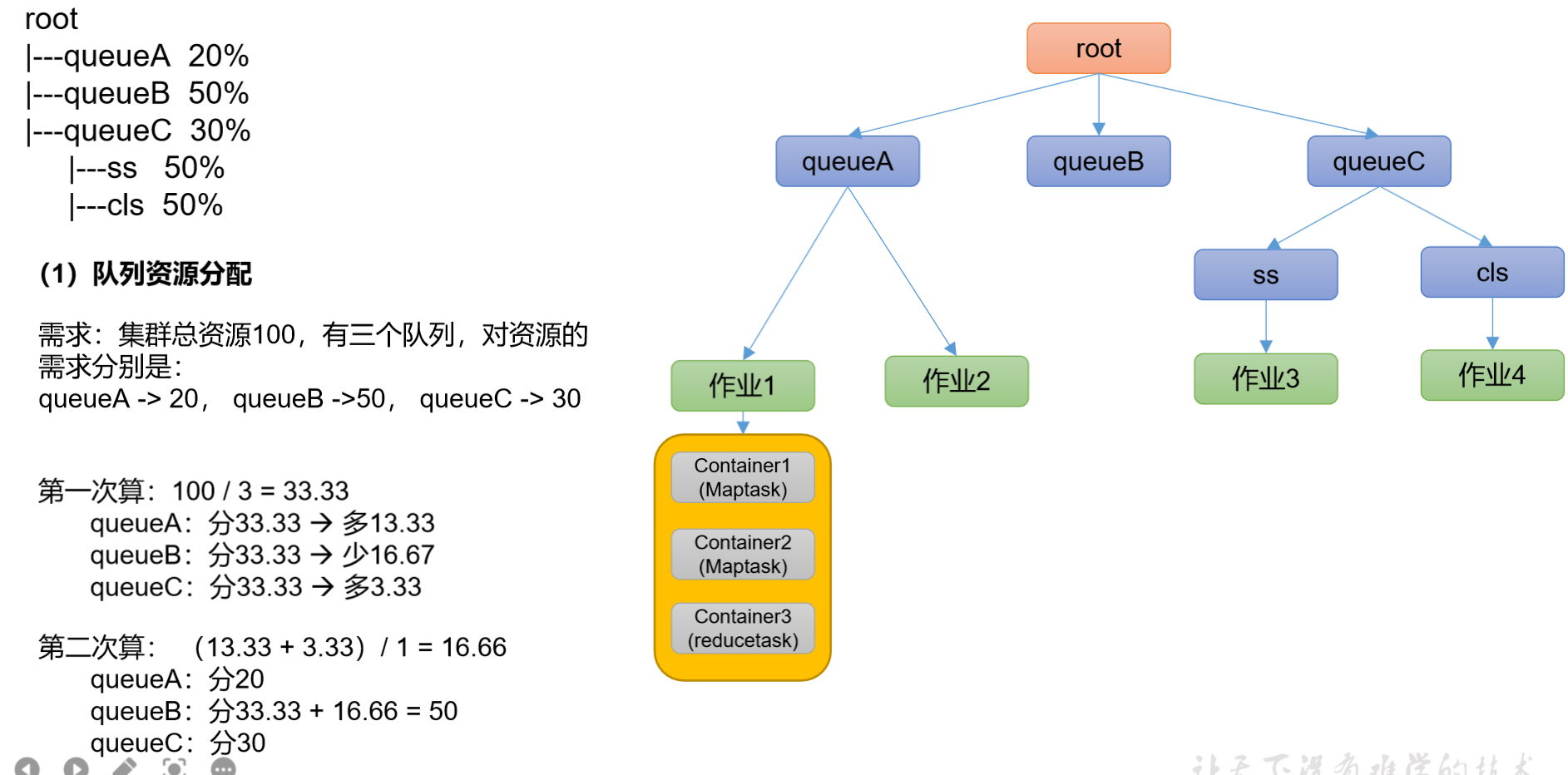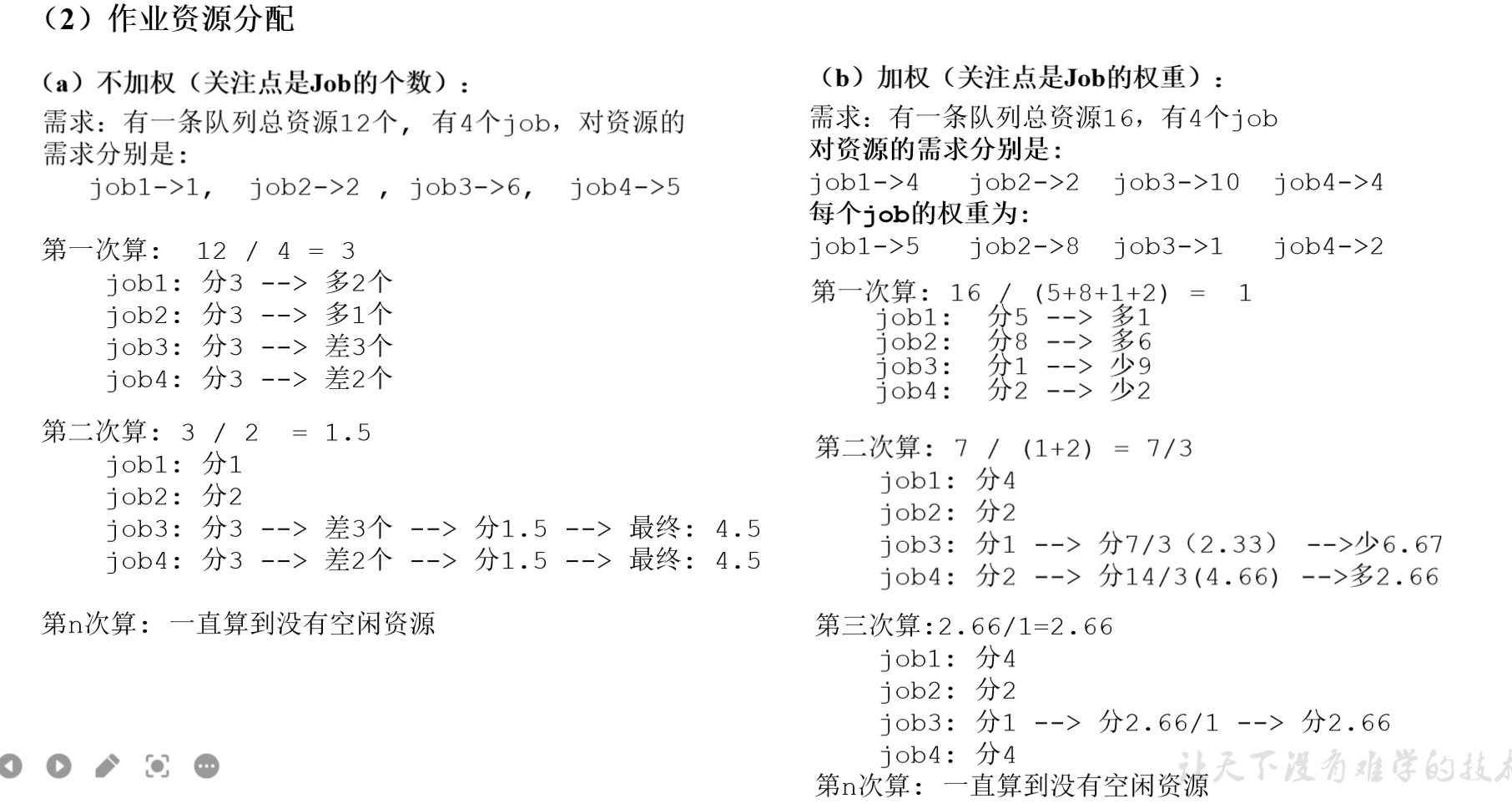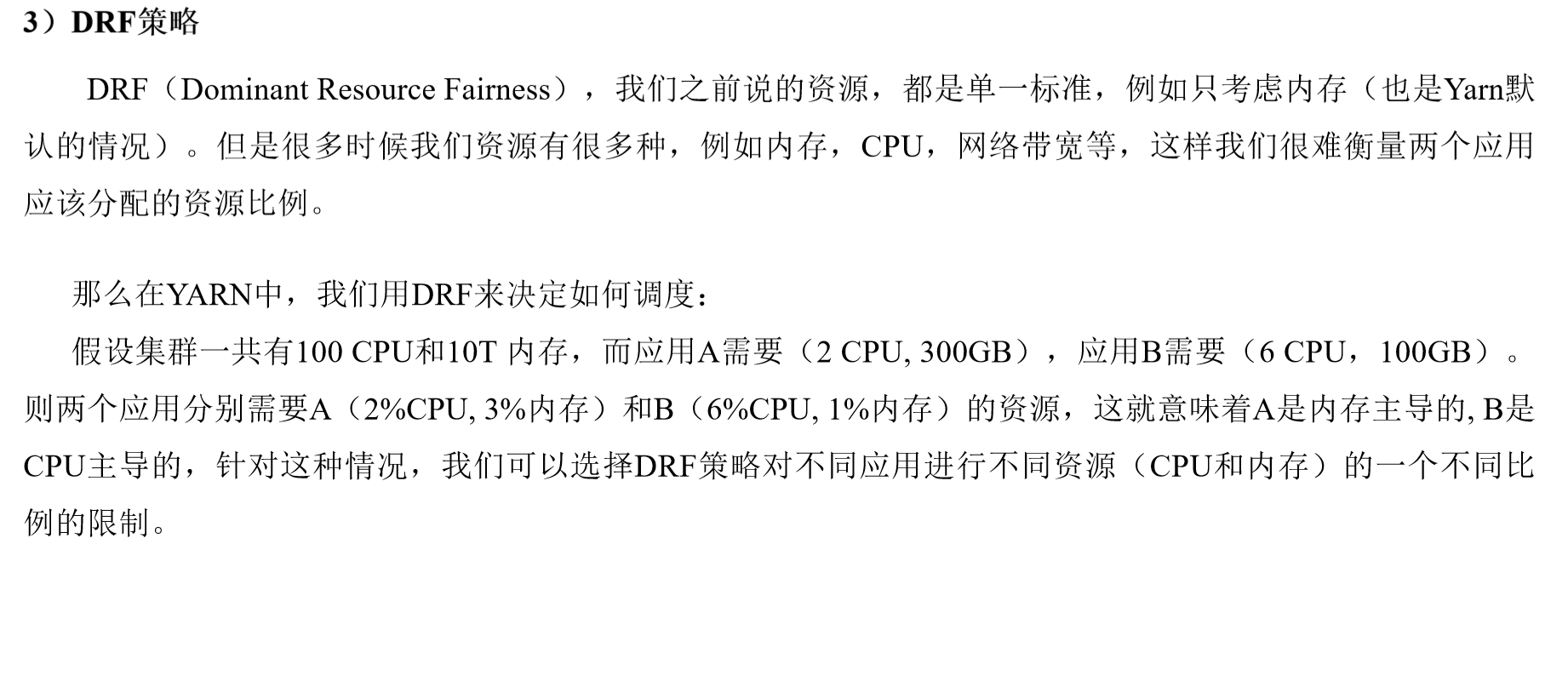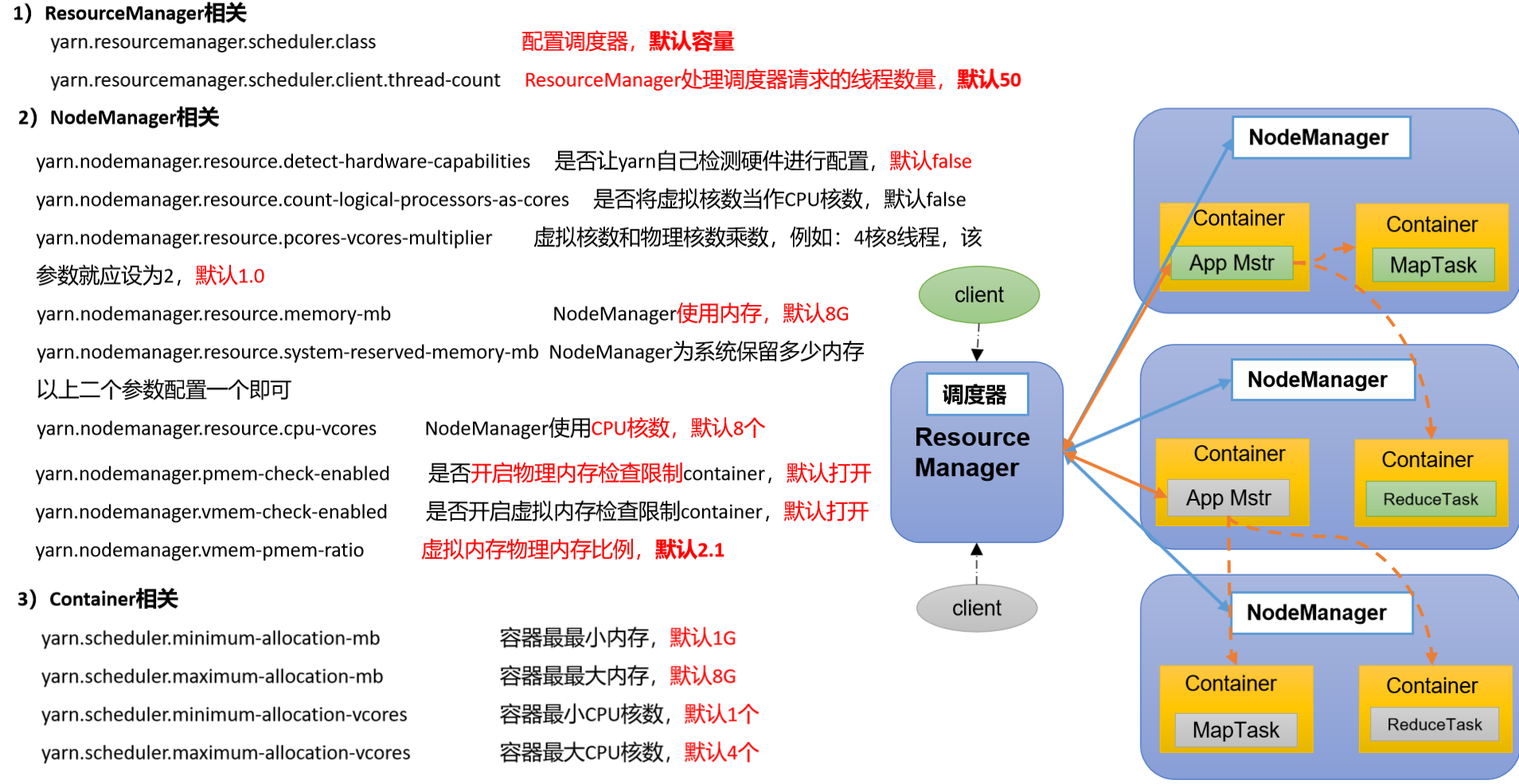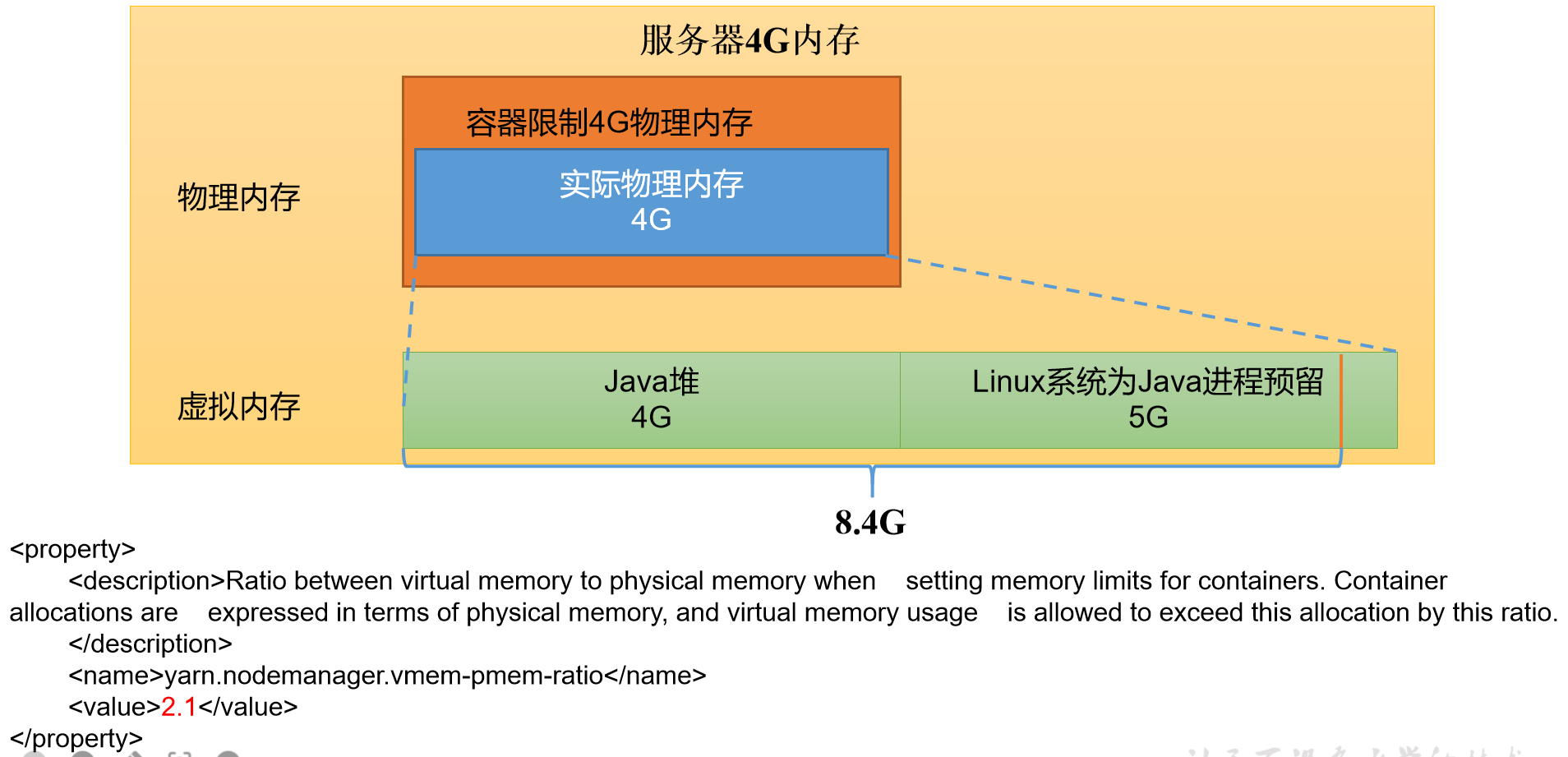YARN
YARN资源调度器
-
YARN是一个资源调度平台,负责为运算程序提供服务器运算资源,相当于一个分布式的操作系统平台,而MapReduce等运算程序则相当于运行于操作系统之上的应用程序
-
YARN基础架构
- YARN主要由ResourceManager、NodeManager、ApplicationMaster和Container等组件构成
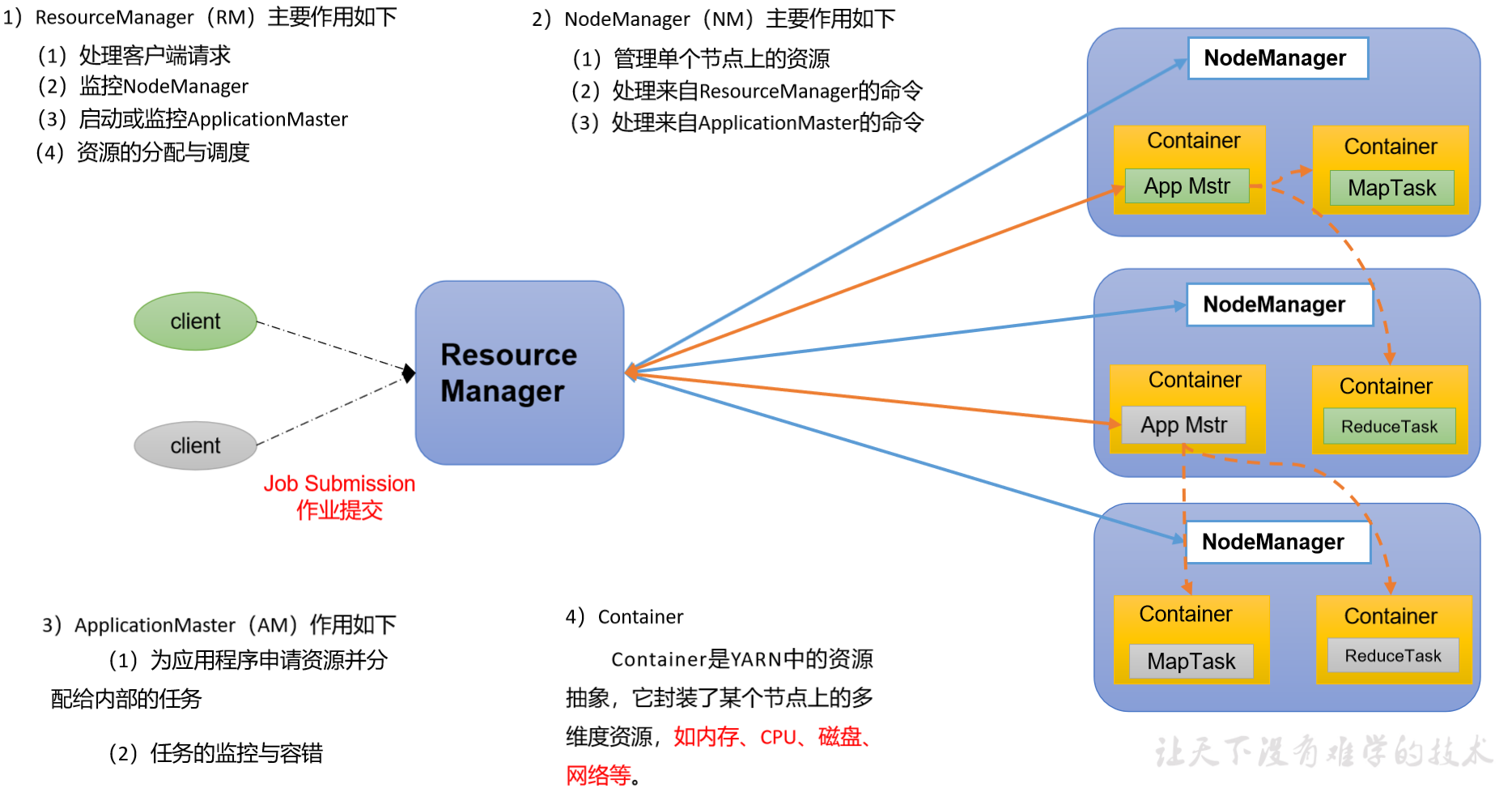
-
YARN工作机制
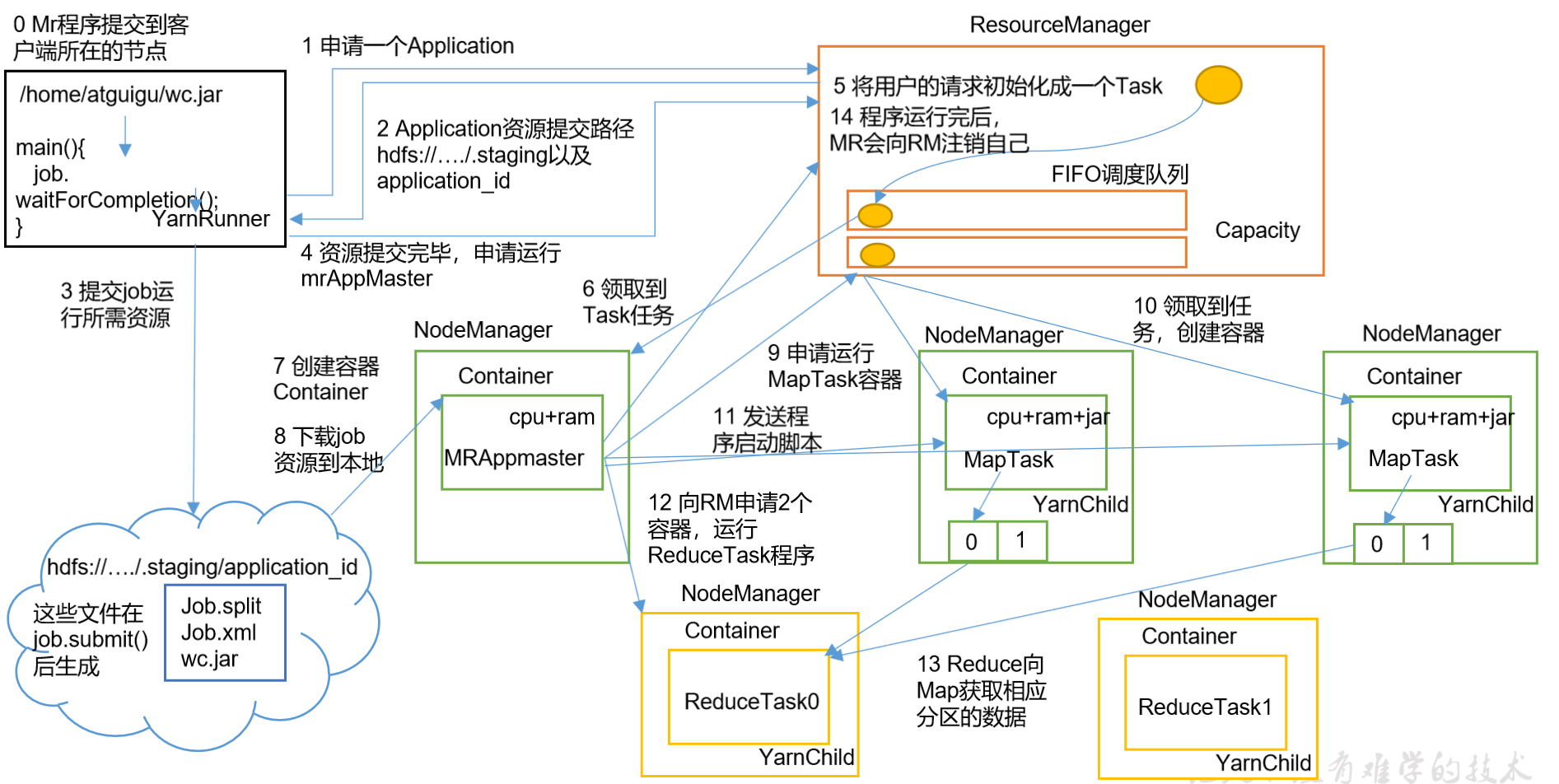
- MR程序提交到客户端所在的节点
- YarnRunner向ResourceManager申请一个Application
- RM将该应用程序的资源路径返回给YarnRunner
- 该程序将运行所需的资源提交到HDFS上
- 程序资源提交完毕后,申请运行MRAppMaster
- RM将用户的请求初始化成一个Task
- 其中一个NodeManager领取到Task任务
- 该NodeManager创建容器Container,并产生MRAPPMaster
- Container从HDFS上拷贝资源到本地
- MRAppMaster向RM申请运行MapTask资源
- RM将运行MapTask任务分配给另外两个NodeManager,另两个NodeManager分别领取任务并创建容器
- MR向两个接收到任务的NodeManager发送程序启动脚本,这两个NodeManager分别启动MapTask、MapTask对数据分区排序
- MRAppMaster等待所有MapTask运行完毕后,向RM申请容器,运行ReduceTask
- ReduceTask向MapTask获取相应分区的数据
- 程序运行完毕后,MR会向RM申请注销自己
-
作业提交全过程
-
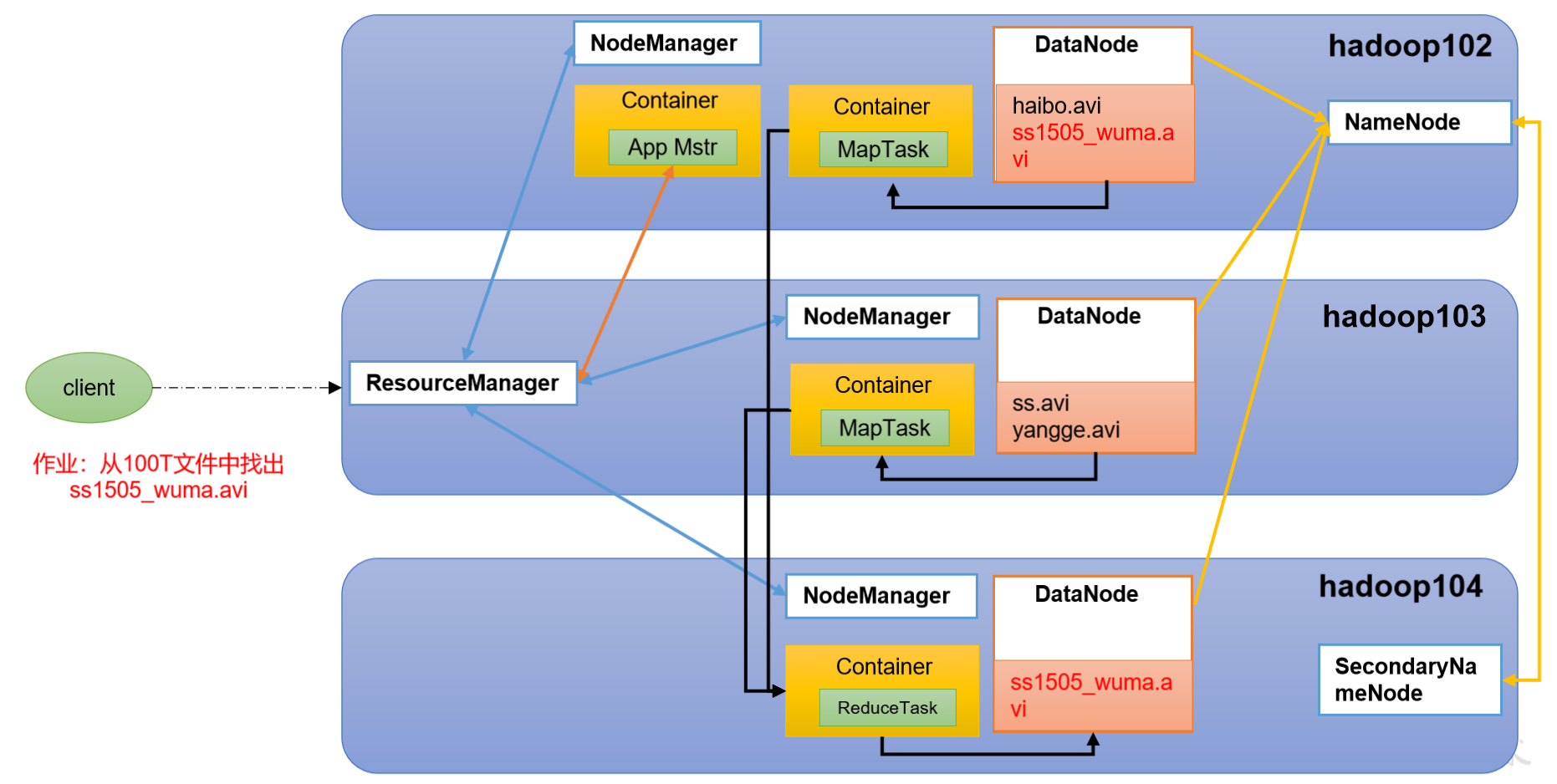
-
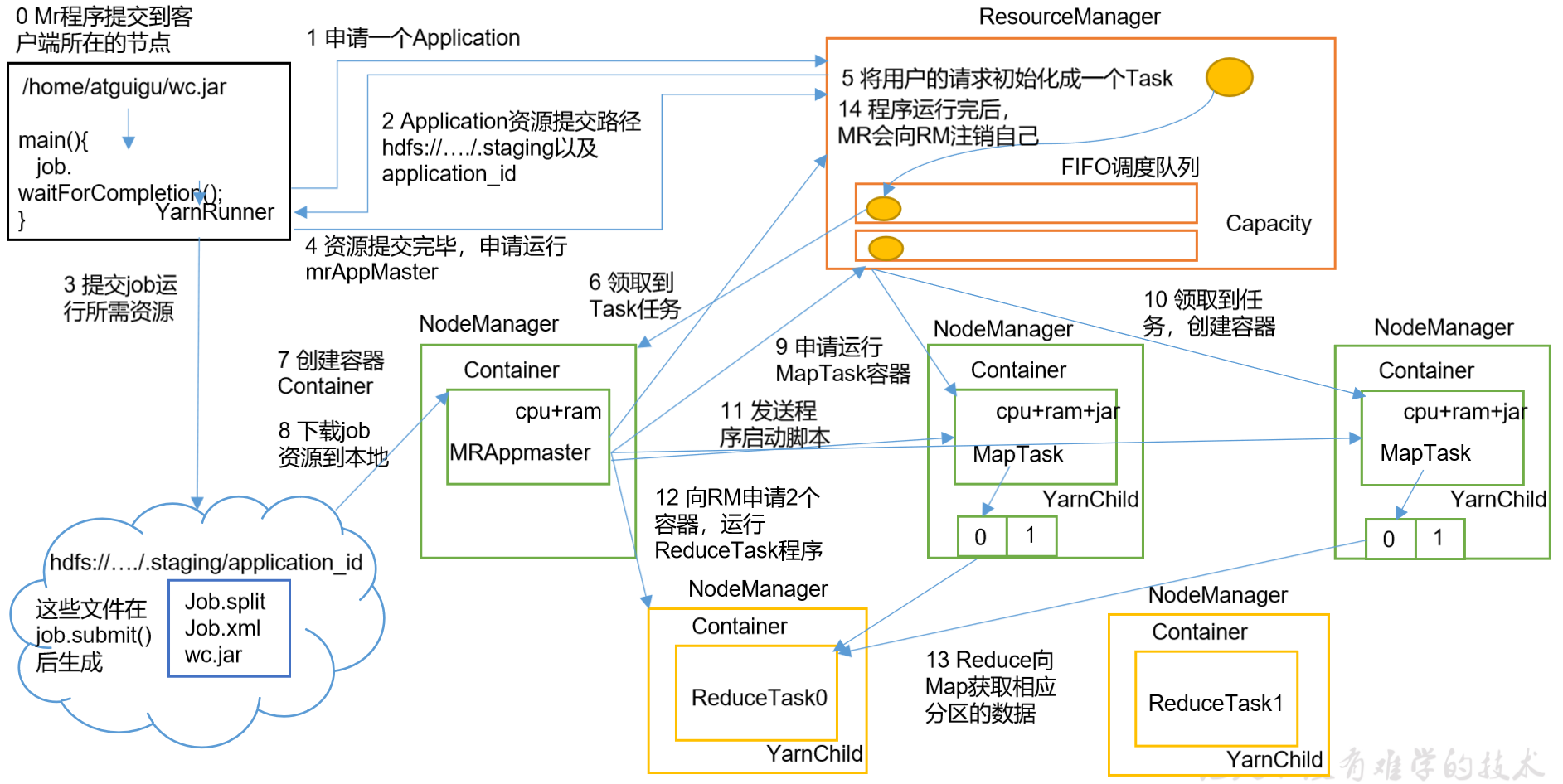
-
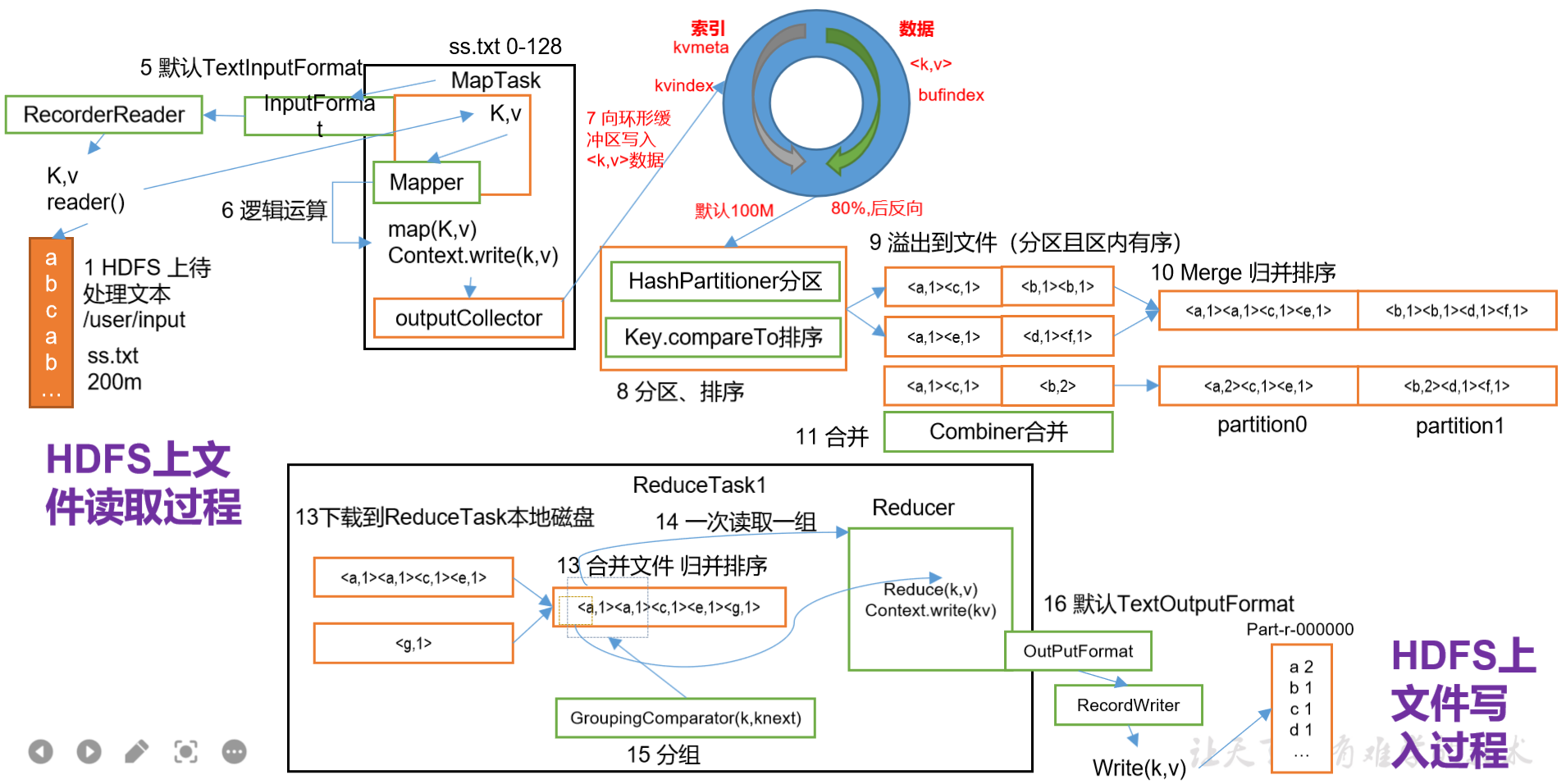
-
作业提交
-
作业初始化
-
任务分配
-
任务运行
-
进度和状态更新
- YARN中的任务将其进度和状态(counter)返回给应用管理器,客户端每秒(通过mapreduce.client.progressmonitor.pollinterval设置)向应用管理器请求进度更新,展示给用户
-
作业完成
- 除了向应用管理器请求作业进度外,客户端每5秒都会通过调用waitForCompletion()来检查作业是否完成。时间间隔可以通过mapreduce.client.completion.pollinterval来设置。作业完成之后,应用管理器和Container会清理工作状态。作业的信息被作业历史服务器存储以备之后用户核查
-
-
YARN调度器和调度算法
-
目前Hadoop作业调度器主要有三种:FIFO、容量(Capacity Scheduler)和公平(Fair Scheduler)。Apache Hadoop3.1.3默认的资源调度器是Capacity Scheduler,CDH框架默认调度器是Fair Scheduler,具体设置详见
-
<property> <description>The class to use as the resource scheduler.</description> <name>yarn.resourcemanager.scheduler.class</name> <value>org.apache.hadoop.yarn.server.resourcemanager.scheduler.capacity.CapacityScheduler</value> </property>
-
-
先进先出调度器(FIFO)
-
FIFO调度器:单队列,根据作业提交的先后顺序,先来先服务
-
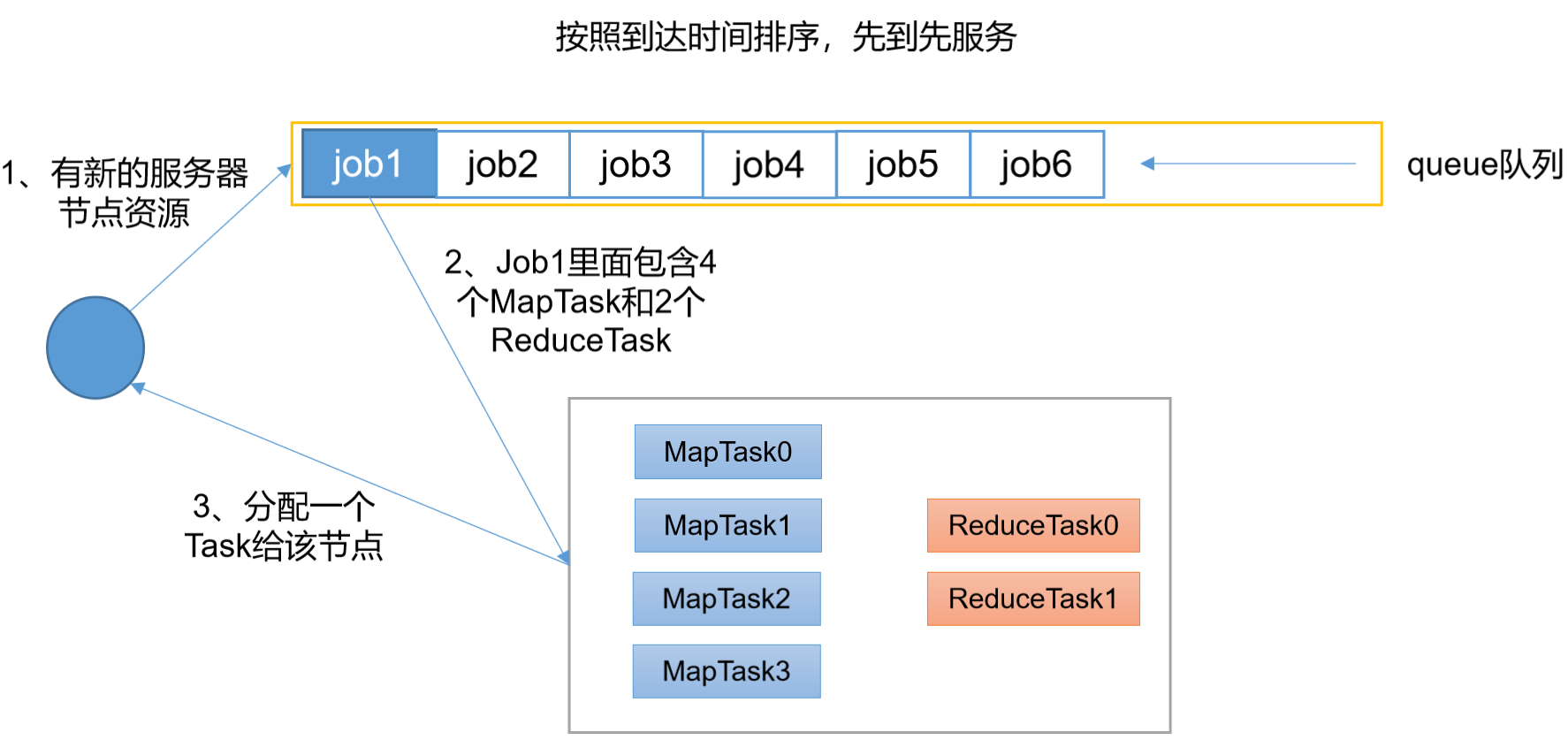
-
优点:简单易懂
-
缺点:不支持队列,生产环境很少使用
-
-
容量调度器(Yahoo开发的多用户调度器)
-
-
公平调度器(Facebook开发)
-
-
-
YARN常用命令
-
yarn application查看任务
-
列出所有Application
-
yarn application -list
-
-
根据Application状态过滤(所有状态:ALL、NEW、NEW_SAVING、SUBMITTED、ACCEPTED、RUNNING、FINISHED、FAILED、KILLED)
-
yarn application -list -appStates FINISHED
-
-
Kill掉Application
-
yarn application -kill application_1612577921195_0001
-
-
-
yarn logs查看日志
-
查询Application日志
-
yarn logs -applicationId application_1612577921195_0001
-
-
查询Container日志
-
yarn logs -applicationId application_1612577921195_0001 -containerId container_1612577921195_0001_01_000001
-
-
-
yarn applicationattempt并查看尝试运行的任务
-
列出所有Application尝试的列表
-
yarn applicationattempt -list application_1612577921195_0001
-
-
打印ApplicationAttempt状态
-
yarn applicationattempt -status appattempt_1612577921195_0001_000001
-
-
-
yarn container查看容器
-
列出所有Container
-
yarn container -list appattempt_1612577921195_0001_000001
-
-
打印Container状态
-
yarn container -status container_1612577921195_0001_01_000001 -
注:只有任务跑的途中才能看到container的状态
-
-
-
yarn node查看节点状态
-
列出所有节点
-
yarn node -list -all
-
-
-
yarn rmadmin更新配置
-
加载队列配置
-
yarn rmadmin -refreshQueues
-
-
-
yarn queue查看队列
-
打印队列信息
-
yarn queue -status default
-
-
-
-
YARN生产环境核心参数
YARN案例实操
-
Yarn生产环境核心参数配置案例
-
1)需求:从1G数据中,统计每个单词出现次数。服务器3台,每台配置4G内存,4核CPU,4线程。 2)需求分析: 1G / 128m = 8个MapTask;1个ReduceTask;1个mrAppMaster 平均每个节点运行10个 / 3台 ≈ 3个任务(4 3 3) 3)修改yarn-site.xml配置参数如下: -
<!-- 选择调度器,默认容量 --> <property> <description>The class to use as the resource scheduler.</description> <name>yarn.resourcemanager.scheduler.class</name> <value>org.apache.hadoop.yarn.server.resourcemanager.scheduler.capacity.CapacityScheduler</value> </property> <!-- ResourceManager处理调度器请求的线程数量,默认50;如果提交的任务数大于50,可以增加该值,但是不能超过3台 * 4线程 = 12线程(去除其他应用程序实际不能超过8) --> <property> <description>Number of threads to handle scheduler interface.</description> <name>yarn.resourcemanager.scheduler.client.thread-count</name> <value>8</value> </property> <!-- 是否让yarn自动检测硬件进行配置,默认是false,如果该节点有很多其他应用程序,建议手动配置。如果该节点没有其他应用程序,可以采用自动 --> <property> <description>Enable auto-detection of node capabilities such as memory and CPU. </description> <name>yarn.nodemanager.resource.detect-hardware-capabilities</name> <value>false</value> </property> <!-- 是否将虚拟核数当作CPU核数,默认是false,采用物理CPU核数 --> <property> <description>Flag to determine if logical processors(such as hyperthreads) should be counted as cores. Only applicable on Linux when yarn.nodemanager.resource.cpu-vcores is set to -1 and yarn.nodemanager.resource.detect-hardware-capabilities is true. </description> <name>yarn.nodemanager.resource.count-logical-processors-as-cores</name> <value>false</value> </property> <!-- 虚拟核数和物理核数乘数,默认是1.0 --> <property> <description>Multiplier to determine how to convert phyiscal cores to vcores. This value is used if yarn.nodemanager.resource.cpu-vcores is set to -1(which implies auto-calculate vcores) and yarn.nodemanager.resource.detect-hardware-capabilities is set to true. The number of vcores will be calculated as number of CPUs * multiplier. </description> <name>yarn.nodemanager.resource.pcores-vcores-multiplier</name> <value>1.0</value> </property> <!-- NodeManager使用内存数,默认8G,修改为4G内存 --> <property> <description>Amount of physical memory, in MB, that can be allocated for containers. If set to -1 and yarn.nodemanager.resource.detect-hardware-capabilities is true, it is automatically calculated(in case of Windows and Linux). In other cases, the default is 8192MB. </description> <name>yarn.nodemanager.resource.memory-mb</name> <value>4096</value> </property> <!-- nodemanager的CPU核数,不按照硬件环境自动设定时默认是8个,修改为4个 --> <property> <description>Number of vcores that can be allocated for containers. This is used by the RM scheduler when allocating resources for containers. This is not used to limit the number of CPUs used by YARN containers. If it is set to -1 and yarn.nodemanager.resource.detect-hardware-capabilities is true, it is automatically determined from the hardware in case of Windows and Linux. In other cases, number of vcores is 8 by default.</description> <name>yarn.nodemanager.resource.cpu-vcores</name> <value>4</value> </property> <!-- 容器最小内存,默认1G --> <property> <description>The minimum allocation for every container request at the RM in MBs. Memory requests lower than this will be set to the value of this property. Additionally, a node manager that is configured to have less memory than this value will be shut down by the resource manager. </description> <name>yarn.scheduler.minimum-allocation-mb</name> <value>1024</value> </property> <!-- 容器最大内存,默认8G,修改为2G --> <property> <description>The maximum allocation for every container request at the RM in MBs. Memory requests higher than this will throw an InvalidResourceRequestException. </description> <name>yarn.scheduler.maximum-allocation-mb</name> <value>2048</value> </property> <!-- 容器最小CPU核数,默认1个 --> <property> <description>The minimum allocation for every container request at the RM in terms of virtual CPU cores. Requests lower than this will be set to the value of this property. Additionally, a node manager that is configured to have fewer virtual cores than this value will be shut down by the resource manager. </description> <name>yarn.scheduler.minimum-allocation-vcores</name> <value>1</value> </property> <!-- 容器最大CPU核数,默认4个,修改为2个 --> <property> <description>The maximum allocation for every container request at the RM in terms of virtual CPU cores. Requests higher than this will throw an InvalidResourceRequestException.</description> <name>yarn.scheduler.maximum-allocation-vcores</name> <value>2</value> </property> <!-- 虚拟内存检查,默认打开,修改为关闭 --> <property> <description>Whether virtual memory limits will be enforced for containers.</description> <name>yarn.nodemanager.vmem-check-enabled</name> <value>false</value> </property> <!-- 虚拟内存和物理内存设置比例,默认2.1 --> <property> <description>Ratio between virtual memory to physical memory when setting memory limits for containers. Container allocations are expressed in terms of physical memory, and virtual memory usage is allowed to exceed this allocation by this ratio. </description> <name>yarn.nodemanager.vmem-pmem-ratio</name> <value>2.1</value> </property> -
关闭虚拟内存检查原因
-
分发配置
-
重启集群
-
sbin/stop-yarn.sh sbin/start-yarn.sh
-
-
-
容量调度器多队列提交案例
-
1)在生产环境怎么创建队列? (1)调度器默认就1个default队列,不能满足生产要求。 (2)按照框架:hive /spark/ flink 每个框架的任务放入指定的队列(企业用的不是特别多) (3)按照业务模块:登录注册、购物车、下单、业务部门1、业务部门2 2)创建多队列的好处? (1)因为担心员工不小心,写递归死循环代码,把所有资源全部耗尽。 (2)实现任务的降级使用,特殊时期保证重要的任务队列资源充足。11.11 6.18 业务部门1(重要)=》业务部门2(比较重要)=》下单(一般)=》购物车(一般)=》登录注册(次要) -
需求
-
需求1:default队列占总内存的40%,最大资源容量占总资源60%,hive队列占总内存的60%,最大资源容量占总资源80%。 需求2:配置队列优先级
-
-
配置多队列的容量调度器
-
在capacity-scheduler.xml中配置如下:
-
<!-- 指定多队列,增加hive队列 --> <property> <name>yarn.scheduler.capacity.root.queues</name> <value>default,hive</value> <description> The queues at the this level (root is the root queue). </description> </property> <!-- 降低default队列资源额定容量为40%,默认100% --> <property> <name>yarn.scheduler.capacity.root.default.capacity</name> <value>40</value> </property> <!-- 降低default队列资源最大容量为60%,默认100% --> <property> <name>yarn.scheduler.capacity.root.default.maximum-capacity</name> <value>60</value> </property> -
为新加队列添加必要属性
-
<!-- 指定hive队列的资源额定容量 --> <property> <name>yarn.scheduler.capacity.root.hive.capacity</name> <value>60</value> </property> <!-- 用户最多可以使用队列多少资源,1表示 --> <property> <name>yarn.scheduler.capacity.root.hive.user-limit-factor</name> <value>1</value> </property> <!-- 指定hive队列的资源最大容量 --> <property> <name>yarn.scheduler.capacity.root.hive.maximum-capacity</name> <value>80</value> </property> <!-- 启动hive队列 --> <property> <name>yarn.scheduler.capacity.root.hive.state</name> <value>RUNNING</value> </property> <!-- 哪些用户有权向队列提交作业 --> <property> <name>yarn.scheduler.capacity.root.hive.acl_submit_applications</name> <value>*</value> </property> <!-- 哪些用户有权操作队列,管理员权限(查看/杀死) --> <property> <name>yarn.scheduler.capacity.root.hive.acl_administer_queue</name> <value>*</value> </property> <!-- 哪些用户有权配置提交任务优先级 --> <property> <name>yarn.scheduler.capacity.root.hive.acl_application_max_priority</name> <value>*</value> </property> <!-- 任务的超时时间设置:yarn application -appId appId -updateLifetime Timeout 参考资料:https://blog.cloudera.com/enforcing-application-lifetime-slas-yarn/ --> <!-- 如果application指定了超时时间,则提交到该队列的application能够指定的最大超时时间不能超过该值。 --> <property> <name>yarn.scheduler.capacity.root.hive.maximum-application-lifetime</name> <value>-1</value> </property> <!-- 如果application没指定超时时间,则用default-application-lifetime作为默认值 --> <property> <name>yarn.scheduler.capacity.root.hive.default-application-lifetime</name> <value>-1</value> </property>
-
-
分发配置文件
-
重启Yarn或者执行yarn rmadmin -refreshQueues刷新队列,就可以看到两条队列
-
向Hive队列提交任务
-
# -D表示运行时改变参数值 hadoop jar share/hadoop/mapreduce/hadoop-mapreduce-examples-3.1.3.jar wordcount -D mapreduce.job.queuename=hive /input /output -
打jar包的方式
-
默认的任务提交都是提交到default队列的。如果希望向其他队列提交任务,需要在Driver中声明:
-
public static void main(String[] args) throws IOException, ClassNotFoundException, InterruptedException { Configuration conf = new Configuration(); conf.set("mapreduce.job.queuename","hive"); //1. 获取一个Job实例 Job job = Job.getInstance(conf); 。。。 。。。 //6. 提交Job boolean b = job.waitForCompletion(true); System.exit(b ? 0 : 1); } }
-
-
-
任务优先级
-
容量调度器,支持任务优先级的配置,在资源紧张时,优先级高的任务将优先获取资源。默认情况,Yarn将所有任务的优先级限制为0,若想使用任务的优先级功能,须开放该限制。 -
修改yarn-site.xml文件,增加以下参数
-
<property> <name>yarn.cluster.max-application-priority</name> <value>5</value> </property>
-
-
分发配置并重启Yarn
-
模拟资源紧张环境,可连续提交以下任务,直到新提交的任务申请不到资源为止
-
再次重新提交优先级高的任务
-
也可以通过以下命令修改正在执行的任务的优先级
-
yarn application -appID application_1611133087930_0009 -updatePriority 5
-
-
-
-
公平调度器案例
-
需求
-
创建两个队列,分别是test和atguigu(以用户所属组命名)。期望实现以下效果:若用户提交任务时指定队列,则任务提交到指定队列运行;若未指定队列,test用户提交的任务到root.group.test队列运行,atguigu提交的任务到root.group.atguigu队列运行(注:group为用户所属组)。 公平调度器的配置涉及到两个文件,一个是yarn-site.xml,另一个是公平调度器队列分配文件fair-scheduler.xml(文件名可自定义)。 (1)配置文件参考资料: https://hadoop.apache.org/docs/r3.1.3/hadoop-yarn/hadoop-yarn-site/FairScheduler.html (2)任务队列放置规则参考资料: https://blog.cloudera.com/untangling-apache-hadoop-yarn-part-4-fair-scheduler-queue-basics/
-
-
配置多队列的公平调度器
-
修改yarn-site.xml文件,加入以下参数
-
<property> <name>yarn.resourcemanager.scheduler.class</name> <value>org.apache.hadoop.yarn.server.resourcemanager.scheduler.fair.FairScheduler</value> <description>配置使用公平调度器</description> </property> <property> <name>yarn.scheduler.fair.allocation.file</name> <value>/opt/module/hadoop-3.1.3/etc/hadoop/fair-scheduler.xml</value> <description>指明公平调度器队列分配配置文件</description> </property> <property> <name>yarn.scheduler.fair.preemption</name> <value>false</value> <description>禁止队列间资源抢占</description> </property>
-
-
配置fair-scheduler.xml
-
<?xml version="1.0"?> <allocations> <!-- 单个队列中Application Master占用资源的最大比例,取值0-1 ,企业一般配置0.1 --> <queueMaxAMShareDefault>0.5</queueMaxAMShareDefault> <!-- 单个队列最大资源的默认值 test atguigu default --> <queueMaxResourcesDefault>4096mb,4vcores</queueMaxResourcesDefault> <!-- 增加一个队列test --> <queue name="test"> <!-- 队列最小资源 --> <minResources>2048mb,2vcores</minResources> <!-- 队列最大资源 --> <maxResources>4096mb,4vcores</maxResources> <!-- 队列中最多同时运行的应用数,默认50,根据线程数配置 --> <maxRunningApps>4</maxRunningApps> <!-- 队列中Application Master占用资源的最大比例 --> <maxAMShare>0.5</maxAMShare> <!-- 该队列资源权重,默认值为1.0 --> <weight>1.0</weight> <!-- 队列内部的资源分配策略 --> <schedulingPolicy>fair</schedulingPolicy> </queue> <!-- 增加一个队列atguigu --> <queue name="atguigu" type="parent"> <!-- 队列最小资源 --> <minResources>2048mb,2vcores</minResources> <!-- 队列最大资源 --> <maxResources>4096mb,4vcores</maxResources> <!-- 队列中最多同时运行的应用数,默认50,根据线程数配置 --> <maxRunningApps>4</maxRunningApps> <!-- 队列中Application Master占用资源的最大比例 --> <maxAMShare>0.5</maxAMShare> <!-- 该队列资源权重,默认值为1.0 --> <weight>1.0</weight> <!-- 队列内部的资源分配策略 --> <schedulingPolicy>fair</schedulingPolicy> </queue> <!-- 任务队列分配策略,可配置多层规则,从第一个规则开始匹配,直到匹配成功 --> <queuePlacementPolicy> <!-- 提交任务时指定队列,如未指定提交队列,则继续匹配下一个规则; false表示:如果指定队列不存在,不允许自动创建--> <rule name="specified" create="false"/> <!-- 提交到root.group.username队列,若root.group不存在,不允许自动创建;若root.group.user不存在,允许自动创建 --> <rule name="nestedUserQueue" create="true"> <rule name="primaryGroup" create="false"/> </rule> <!-- 最后一个规则必须为reject或者default。Reject表示拒绝创建提交失败,default表示把任务提交到default队列 --> <rule name="reject" /> </queuePlacementPolicy> </allocations>
-
-
分发配置并重启yarn
-
-
测试提交任务
-
提交任务时指定队列,按照配置规则,任务会到指定的root.test队列
-
hadoop jar /opt/module/hadoop-3.1.3/share/hadoop/mapreduce/hadoop-mapreduce-examples-3.1.3.jar pi -Dmapreduce.job.queuename=root.test 1 1
-
-
提交任务时不指定队列,按照配置规则,任务会到root.atguigu.atguigu队列
-
hadoop jar /opt/module/hadoop-3.1.3/share/hadoop/mapreduce/hadoop-mapreduce-examples-3.1.3.jar pi 1 1
-
-
-
-
Yarn的Tool接口案例(实现动态传参)
-
新建Maven项目YarnDemo,pom如下
-
<?xml version="1.0" encoding="UTF-8"?> <project xmlns="http://maven.apache.org/POM/4.0.0" xmlns:xsi="http://www.w3.org/2001/XMLSchema-instance" xsi:schemaLocation="http://maven.apache.org/POM/4.0.0 http://maven.apache.org/xsd/maven-4.0.0.xsd"> <modelVersion>4.0.0</modelVersion> <groupId>com.atguigu.hadoop</groupId> <artifactId>yarn_tool_test</artifactId> <version>1.0-SNAPSHOT</version> <dependencies> <dependency> <groupId>org.apache.hadoop</groupId> <artifactId>hadoop-client</artifactId> <version>3.1.3</version> </dependency> </dependencies> </project>
-
-
新建com.lotuslaw.yarn包名
-
创建类WordCount并实现Tool接口
-
package com.lotuslaw.yarn; import org.apache.hadoop.conf.Configuration; import org.apache.hadoop.fs.Path; import org.apache.hadoop.io.IntWritable; import org.apache.hadoop.io.LongWritable; import org.apache.hadoop.io.Text; import org.apache.hadoop.mapreduce.Job; import org.apache.hadoop.mapreduce.Mapper; import org.apache.hadoop.mapreduce.Reducer; import org.apache.hadoop.mapreduce.lib.input.FileInputFormat; import org.apache.hadoop.mapreduce.lib.output.FileOutputFormat; import org.apache.hadoop.util.Tool; import java.io.IOException; public class WordCount implements Tool { private Configuration conf; @Override public int run(String[] args) throws Exception { Job job = Job.getInstance(conf); job.setJarByClass(WordCountDriver.class); job.setMapperClass(WordCountMapper.class); job.setReducerClass(WordCountReducer.class); job.setMapOutputKeyClass(Text.class); job.setMapOutputValueClass(IntWritable.class); job.setOutputKeyClass(Text.class); job.setOutputValueClass(IntWritable.class); FileInputFormat.setInputPaths(job, new Path(args[0])); FileOutputFormat.setOutputPath(job, new Path(args[1])); return job.waitForCompletion(true) ? 0 : 1; } @Override public void setConf(Configuration conf) { this.conf = conf; } @Override public Configuration getConf() { return conf; } public static class WordCountMapper extends Mapper<LongWritable, Text, Text, IntWritable> { private Text outK = new Text(); private IntWritable outV = new IntWritable(1); @Override protected void map(LongWritable key, Text value, Context context) throws IOException, InterruptedException { String line = value.toString(); String[] words = line.split(" "); for (String word : words) { outK.set(word); context.write(outK, outV); } } } public static class WordCountReducer extends Reducer<Text, IntWritable, Text, IntWritable> { private IntWritable outV = new IntWritable(); @Override protected void reduce(Text key, Iterable<IntWritable> values, Context context) throws IOException, InterruptedException { int sum = 0; for (IntWritable value : values) { sum += value.get(); } outV.set(sum); context.write(key, outV); } } }
-
-
新建WordCountDriver
-
package com.lotuslaw.yarn; import org.apache.hadoop.conf.Configuration; import org.apache.hadoop.util.Tool; import org.apache.hadoop.util.ToolRunner; import java.util.Arrays; public class WordCountDriver { private static Tool tool; public static void main(String[] args) throws Exception { // 1. 创建配置文件 Configuration conf = new Configuration(); // 2. 判断是否有tool接口 switch (args[0]){ case "wordcount": tool = new WordCount(); break; default: throw new RuntimeException(" No such tool: "+ args[0] ); } // 3. 用Tool执行程序 // Arrays.copyOfRange 将老数组的元素放到新数组里面 int run = ToolRunner.run(conf, tool, Arrays.copyOfRange(args, 1, args.length)); System.exit(run); } }
-
-
打包上传集群,测试
-
yarn jar YarnDemo.jar com.atguigu.yarn.WordCountDriver wordcount -Dmapreduce.job.queuename=root.test /input /output1
-
-
